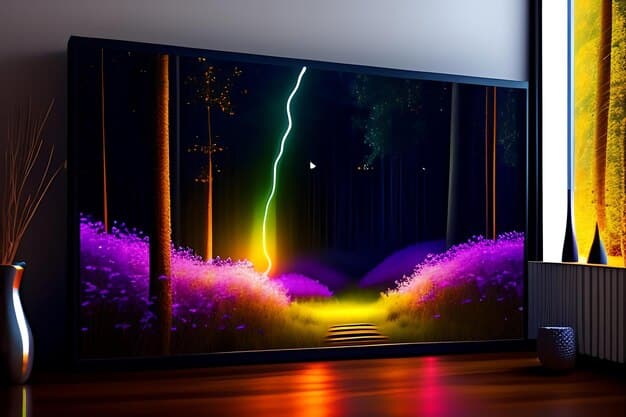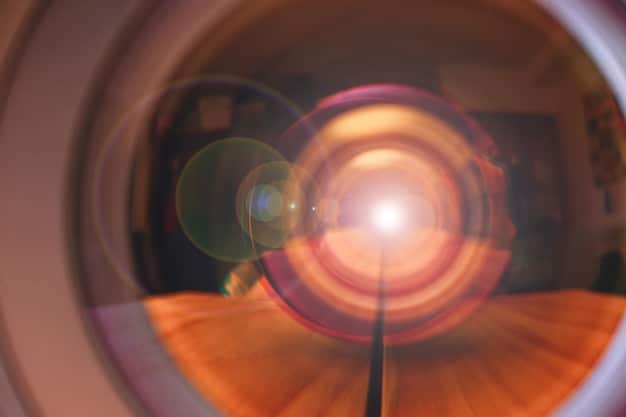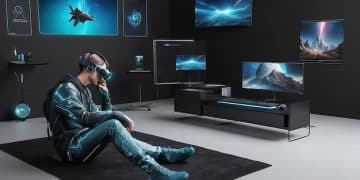Choosing the Right Home Theater Projector: A Cinematic Guide

Choosing the right home theater projector involves balancing resolution, brightness, contrast ratio, and throw distance to create an immersive cinematic experience at home.
Creating a cinematic experience at home is now easier than ever, thanks to advancements in home theater technology. Choosing the right home theater projector for a cinematic experience, however, can be daunting. This guide simplifies the process, helping you select the perfect projector for your needs.
Understanding Home Theater Projector Basics
Before diving into the specifics, it’s essential to grasp the key components that define a home theater projector. Understanding these basics will help you make a more informed decision tailored to your viewing environment and preferences.
What Makes a Projector “Home Theater”?
Home theater projectors are designed to deliver high-quality images and immersive viewing experiences. They typically offer higher resolutions, better contrast ratios, and more accurate color reproduction than standard projectors.
Key Features to Consider
Several features contribute to the overall performance of a home theater projector. These include resolution, brightness, contrast ratio, color accuracy, and connectivity options.

Here’s a list of crucial factors to think about:
- Resolution: The number of pixels displayed determines the image’s clarity and detail.
- Brightness: Measured in lumens, brightness affects how well the image is visible in different lighting conditions.
- Contrast Ratio: This measures the difference between the darkest and brightest parts of the image, impacting picture depth.
- Color Accuracy: Accurate color reproduction is crucial for a realistic and engaging viewing experience.
By understanding these basic elements, you’ll be better prepared to evaluate different projector models and choose one that aligns with your home theater aspirations. Keep these factors in mind as we delve deeper into the selection process.
Assessing Your Viewing Environment
The environment where you plan to set up your home theater significantly impacts the type of projector you should choose. Factors like room size, ambient light, and screen size play crucial roles in determining the optimal projector specifications.
Room Size and Throw Distance
The size of your room dictates the projector’s throw distance, which is the distance between the projector and the screen. Different projectors have different throw ratios, so it’s important to select one that fits your available space.
Ambient Light Considerations
Ambient light can wash out the projected image, reducing contrast and color vibrancy. If your room isn’t completely dark, you’ll need a projector with higher brightness to compensate.
Here are some strategies to mitigate ambient light:
- Blackout Curtains: Install blackout curtains to block external light sources.
- Dark Walls: Paint your walls with dark colors to absorb light and reduce reflections.
- Light Control: Use dimmable lights to adjust the room’s brightness as needed.
Carefully evaluating your viewing environment will ensure that you select a projector that delivers optimal performance in your specific setting. This assessment is vital for achieving the best possible cinematic experience in your home.
Understanding Key Projector Specifications
Delving into the specifications of different projectors can seem overwhelming, but understanding these details is crucial for making an informed decision. Let’s break down the key specs you need to consider.
Resolution: The Clarity of Your Image
Resolution refers to the number of pixels that make up the image. Higher resolutions result in sharper and more detailed pictures. Common resolutions for home theater projectors include:
- 1080p (Full HD): 1920 x 1080 pixels – A standard for many streaming services and Blu-ray discs.
- 4K UHD: 3840 x 2160 pixels – Offers four times the resolution of 1080p, providing incredible detail and clarity.
- 8K UHD: 7680 x 4320 pixels – The highest resolution currently available, delivering unparalleled image quality (though content is limited).
Brightness: Illuminating Your Screen
Brightness, measured in lumens, determines how well the projector’s image will appear in various lighting conditions. The required brightness depends on the room’s ambient light and the screen size.
Contrast Ratio: The Depth of Your Image
The contrast ratio is the difference between the darkest black and the brightest white the projector can produce. A higher contrast ratio results in deeper blacks and brighter whites, enhancing the overall picture quality.

Understanding these key specifications will enable you to compare different projectors effectively and select one that meets your specific viewing requirements. Pay attention to these details to ensure an immersive and visually stunning home theater experience.
Exploring Projector Technology Types
Home theater projectors utilize various technologies to create images. Each technology has its own strengths and weaknesses, impacting picture quality, cost, and maintenance. Let’s explore some of the most common types.
DLP (Digital Light Processing)
DLP projectors use tiny mirrors to reflect light and create images. They are known for their sharp picture quality, high contrast ratios, and fast response times, making them suitable for action movies and gaming.
LCD (Liquid Crystal Display)
LCD projectors use liquid crystal panels to modulate light and produce images. They offer excellent color accuracy and brightness, making them a good choice for bright rooms and presentations.
LCoS (Liquid Crystal on Silicon)
LCoS projectors combine elements of both DLP and LCD technologies. They deliver high contrast ratios, excellent color accuracy, and smooth motion handling, making them a premium choice for home theaters.
Considering these technology types, here’s what you should keep in mind:
- DLP: Best for sharp images and high contrast.
- LCD: Ideal for color accuracy and brightness in well-lit rooms.
- LCoS: A premium option for the best overall picture quality.
Choosing the right projector technology depends on your specific viewing preferences and budget. Understanding the differences between these technologies will help you make a more informed decision.
Considering Additional Features and Connectivity
Beyond the core specifications, additional features and connectivity options can enhance your home theater experience. These include smart capabilities, lens shift, keystone correction, and various input options.
Smart Features and Functionality
Many modern projectors come with built-in smart platforms, allowing you to stream content directly from services like Netflix, Hulu, and Amazon Prime Video. These smart features eliminate the need for external streaming devices.
Lens Shift and Keystone Correction
Lens shift and keystone correction are features that help you align the projected image without physically moving the projector. Lens shift allows for vertical and horizontal adjustments, while keystone correction corrects image distortion.
Key connectivity options include:
- HDMI: For connecting Blu-ray players, gaming consoles, and streaming devices.
- USB: For playing media from USB drives and powering accessories.
- Wireless Connectivity: For streaming content wirelessly from your smartphone or tablet.
Taking these extra features into account will help you tailor your projector choice to meet your distinct requirements. These enhancements can significantly improve the ease of use and the overall satisfaction of your home theater setup.
Budget and Long-Term Costs
Setting a budget for your home theater projector is crucial. While it’s tempting to opt for the cheapest option, consider the long-term costs associated with maintenance, lamp replacement, and energy consumption.
Initial Purchase Price
Projector prices vary widely depending on their specifications and features. Determine how much you’re willing to spend upfront, and then research models within that price range.
Lamp Replacement Costs
Projector lamps have a limited lifespan and will eventually need to be replaced. Factor in the cost of replacement lamps when evaluating different models. LED and laser projectors offer longer lifespans and lower maintenance costs compared to traditional lamp-based projectors.
Here are some variables to consider when determining long-term costs:
- Lamp Life: Check the estimated lamp life hours for each projector model.
- Energy Consumption: Consider the projector’s power consumption and its impact on your electricity bill.
- Warranty: Look for projectors with comprehensive warranties to protect against potential defects.
By factoring in these long-term costs, you can make a more financially sound decision and avoid unexpected expenses down the road. A projector that fits your budget and offers reasonable maintenance costs will provide the best value over time.
| Key Point | Brief Description |
|---|---|
| 💡 Resolution | Higher resolution (4K or 8K) provides sharper, more detailed images for a cinematic experience. |
| 🔆 Brightness | More lumens are needed for rooms with ambient light; aim for 2000+ lumens for versatility. |
| 🖼️ Contrast Ratio | A higher contrast ratio ensures deeper blacks and brighter whites, enhancing image depth. |
| 📏 Throw Distance | Match the projector’s throw ratio to your room size to project the ideal image size. |
FAQ
▼
4K UHD (3840 x 2160 pixels) is generally recommended for the best viewing experience, offering excellent detail and clarity. However, 1080p (Full HD) can still provide a good picture, especially if you’re on a budget or have limited space.
▼
The number of lumens depends on the amount of ambient light in your room. For a dark room, 1500-2000 lumens may suffice. For rooms with more ambient light, 2000-3000+ lumens are recommended to ensure a bright and clear picture.
▼
A contrast ratio of 3000:1 or higher is considered good for a home theater projector. Higher contrast ratios provide deeper blacks and brighter whites, enhancing the overall picture quality. Look for projectors with dynamic contrast ratios for even better performance.
▼
DLP projectors use tiny mirrors to reflect light, offering sharp images and high contrast. LCD projectors use liquid crystal panels, providing excellent color accuracy and brightness. Choose based on your priorities and viewing environment.
▼
While you can project onto a white wall, a dedicated projector screen will provide better image quality. Screens are designed to reflect light evenly and enhance contrast and color accuracy. Consider a screen with the appropriate gain for your projector.
Conclusion
Choosing the right home theater projector is a multifaceted process that involves careful consideration of various factors such as resolution, brightness, contrast ratio, and viewing environment. By understanding these key aspects and balancing them with your budget, you can create an immersive and cinematic experience right in the comfort of your home.





